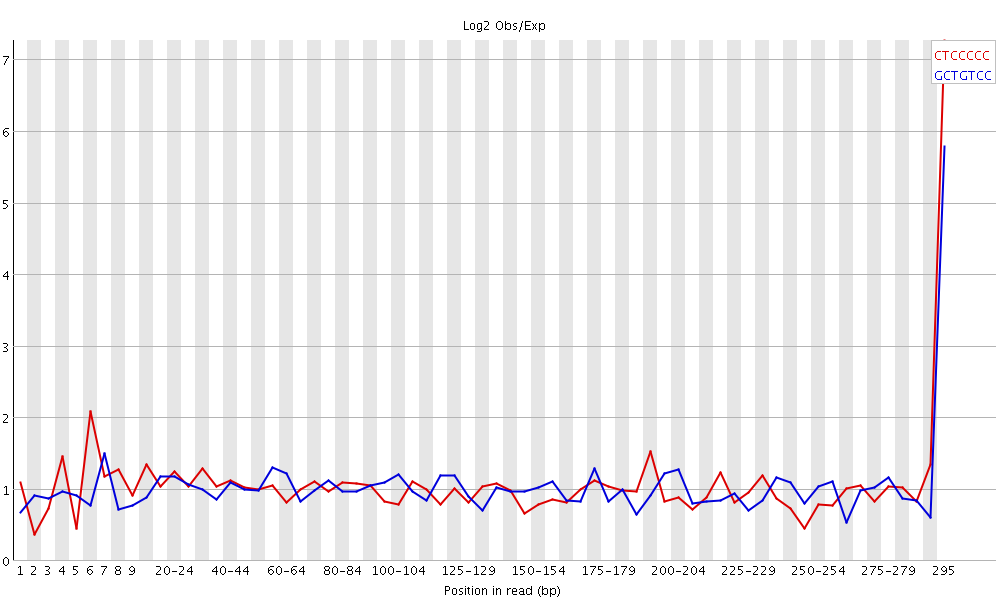I have genomic DNA that was PE sequenced on the MiSeq platform. I understand there must've been some adapter read through due to the large read sizes. Even after trimming, I still get some enriched kmers and skewed GC content on either end of both pairs of reads. Here are some Kmer content graphs:  ,
,  ,
,  ,
,  ,
,  ,
, 
Here are some examples of per base GC content: ,
, 
I ran trimmomatic with
PE -phred33 ILLUMINACLIP:TruSeq2-PE.fa:2:20:7:2 LEADING:13 TRAILING:13 SLIDINGWINDOW:4:15 MINLEN:36
My adapter file
$ cat TruSeq2-PE.fa
>PrefixPE/1
AATGATACGGCGACCACCGAGATCTACACTCTTTCCCTACACGACGCTCTTCCGATCT
>PrefixPE/2
CAAGCAGAAGACGGCATACGAGATCGGTCTCGGCATTCCTGCTGAACCGCTCTTCCGATCT
>PCR_Primer1
AATGATACGGCGACCACCGAGATCTACACTCTTTCCCTACACGACGCTCTTCCGATCT
>PCR_Primer1_rc
AGATCGGAAGAGCGTCGTGTAGGGAAAGAGTGTAGATCTCGGTGGTCGCCGTATCATT
>PCR_Primer2
CAAGCAGAAGACGGCATACGAGATCGGTCTCGGCATTCCTGCTGAACCGCTCTTCCGATCT
>PCR_Primer2_rc
AGATCGGAAGAGCGGTTCAGCAGGAATGCCGAGACCGATCTCGTATGCCGTCTTCTGCTTG
>FlowCell1
TTTTTTTTTTAATGATACGGCGACCACCGAGATCTACAC
>FlowCell2
TTTTTTTTTTCAAGCAGAAGACGGCATACGA
 ,
,  ,
,  ,
,  ,
,  ,
, 
Here are some examples of per base GC content:
 ,
, 
I ran trimmomatic with
PE -phred33 ILLUMINACLIP:TruSeq2-PE.fa:2:20:7:2 LEADING:13 TRAILING:13 SLIDINGWINDOW:4:15 MINLEN:36
My adapter file
$ cat TruSeq2-PE.fa
>PrefixPE/1
AATGATACGGCGACCACCGAGATCTACACTCTTTCCCTACACGACGCTCTTCCGATCT
>PrefixPE/2
CAAGCAGAAGACGGCATACGAGATCGGTCTCGGCATTCCTGCTGAACCGCTCTTCCGATCT
>PCR_Primer1
AATGATACGGCGACCACCGAGATCTACACTCTTTCCCTACACGACGCTCTTCCGATCT
>PCR_Primer1_rc
AGATCGGAAGAGCGTCGTGTAGGGAAAGAGTGTAGATCTCGGTGGTCGCCGTATCATT
>PCR_Primer2
CAAGCAGAAGACGGCATACGAGATCGGTCTCGGCATTCCTGCTGAACCGCTCTTCCGATCT
>PCR_Primer2_rc
AGATCGGAAGAGCGGTTCAGCAGGAATGCCGAGACCGATCTCGTATGCCGTCTTCTGCTTG
>FlowCell1
TTTTTTTTTTAATGATACGGCGACCACCGAGATCTACAC
>FlowCell2
TTTTTTTTTTCAAGCAGAAGACGGCATACGA
Comment